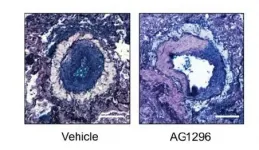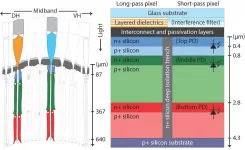Strange isotopes: Scientists explain a methane isotope paradox of the seafloor
Why methane carbon isotopes in the deep sea behave so differently than expected
2021-05-05
(Press-News.org) Methane, a chemical compound with the molecular formula CH4, is not only a powerful greenhouse gas, but also an important energy source. It heats our homes, and even seafloor microbes make a living of it. The microbes use a process called anaerobic oxidation of methane (AOM), which happens commonly in the seafloor in so-called sulfate-methane transition zones - layers in the seafloor where sulfate from the seawater meets methane from the deeper sediment. Here, specialized microorganisms, the ANaerobically MEthane-oxidizing (ANME) archaea, consume the methane. They live in close association with bacteria, which use electrons released during methane oxidation for sulfate reduction. For this purpose, these organisms form characteristic consortia.
This process takes place globally in the seafloor and hence is an important part of the carbon cycle. However, studying the AOM process is challenging because the reaction is very slow. For its investigation, researchers often use a chemical knack: the stable isotope ratios in methane. But unfortunately, these isotopes do not always behave as expected, which led to serious confusion on the role and function of the microbes involved. Now researchers from the Max Planck Institute for Marine Microbiology and the MARUM - Center for Marine Environmental Sciences in Germany together with colleagues from the Weizmann Institute of Science in Israel have solved this isotope enigma and published their results in the journal Science Advances. This paves the way for a better understanding of the important process of anaerobic methane oxidation.
Isotopes reveal reaction pathways
The puzzle and its solution in detail: Isotopes are different "versions" of an element with different masses. The isotopes of an element have the same number of protons (positively charged particles) in the nucleus and therefore the same position in the periodic table (iso topos = Greek, same place). However, they differ in the number of neutrons (neutral particles) in the nucleus. For example, carbon has two stable isotopes, the lighter 12C and the heavier 13C. Additionally, there is the familiar radioactive isotope 14C, a very rare carbon species that is used to determine the age of carbon-bearing materials. Although the chemical properties of the two stable isotopes are identical, the difference in mass results in different reaction rates. When chemical compounds react, the ones with the lighter isotopes are usually converted faster, leaving the heavier variant in the initial reactant. This change in isotopic composition is known as isotopic fractionation, and has been used for decades to track chemical reactions. In the case of methane oxidation, this means that 12C-methane is primarily consumed, leading to an enrichment of 13C in the remaining methane. Conversely, a microbial production of methane (methanogenesis) would result in particularly light methane. "Reality, however, is surprisingly different", Gunter Wegener reports. "Contrary to the logic described above, we often find very light methane in sulfate-methane transition zones."
Nature doesn't follow the textbook: Light methane in sulfate-methane transition zones
This paradox raises questions, such as: Is methane not consumed there, but rather produced? And who, if not the numerous ANME archaea, should be responsible for this? "In my lab, we have the world's largest collection of ANME cultures. There we could try to find out if and how the methane oxidizers themselves could be responsible for the formation of light methane," Wegener continues. "The first results were deflating: At the high sulfate concentrations we normally find in seawater, the cultured microorganisms behaved according to the textbook. The remaining methane was enriched in the heavier isotopes." However, if the same experiments were carried out with little sulfate, methane got enriched in 12C, it became lighter. And this happened even though methane continued to be consumed at the same time - an effect that at first glance had little logic.
The availability of sulfate governs the isotopes effects in AOM
So how could they explain the unusual behavior of the methane isotopes? Jonathan Gropp and his mentor Itay Halevy from the Weizmann Institute of Science in Israel have spent years studying the isotope effects of microbial metabolisms, including methanogenesis - a reaction that is catalyzed by the same enzymes as the anaerobic oxidation of methane (AOM). Thus, they were the ideal partners for the team located in Bremen. "Both processes are based on a very similar cascade of seven reactions," says Gropp. "Previous studies have shown that all of these reactions are potentially reversible, meaning that they can take place in both directions. Each reaction also has its own isotope effects." With the help of a model, Gropp was able to show that, depending on how much sulfate is available, the partial reactions can be reversed to varying degrees. This could then lead to the situation that heavy isotopes are not as usual left behind but are stuck in the reaction chain, while light isotopes are channeled back to methane. "The microbes want to perform the reaction but are limited to do so because of the low sulfate concentrations," explains Gropp, adding that "Our designed model fits the isotope experiments very nicely."
The long hours in the laboratory and in front of the computer paid off for the researchers. With their study, Wegener, Gropp and their colleagues could show how AOM results in 13C-depleted methane. The experiments with little sulfate in particular nicely reflect the conditions in the natural habitat of the microorganisms, the sulfate-methane transition zones in the seafloor. There, the microorganisms often thrive on only little sulfate, as in the low-sulfate experiments. "Now we know that methane oxidizers can be responsible for the build-up of light isotopes in methane at sulfate-methane transition zones. Methanogenesis is not required for that. As we suspected, the ANME are methane oxidizers," concludes Marcus Elvert, last author of the current study. Now the researchers are ready for the next step and want to find if other reactions show similar isotope effects.
INFORMATION:
[Attachments] See images for this press release:

ELSE PRESS RELEASES FROM THIS DATE:
2021-05-05
Who made more accurate predictions about the course of the COVID-19 pandemic - experts or the public? A study from the University of Cambridge has found that experts such as epidemiologists and statisticians made far more accurate predictions than the public, but both groups substantially underestimated the true extent of the pandemic.
Researchers from the Winton Centre for Risk and Evidence Communication surveyed 140 UK experts and 2,086 UK laypersons in April 2020 and asked them to make four quantitative predictions about the impact of COVID-19 by the end of 2020. Participants were also asked to indicate confidence in their predictions by providing upper and lower bounds of where they were 75% sure that the true answer would fall - for example, ...
2021-05-05
When access to free and low-cost birth control goes up, the percentage of young women who leave high school before graduating goes down by double-digits, according to a new CU Boulder-led study published May 5 in the journal Science Advances.
The study, which followed more than 170,000 women for up to seven years, provides some of the strongest evidence yet that access to contraception yields long-term socioeconomic benefits for women. It comes at a time when public funding for birth control is undergoing heated debate, and some states are considering banning certain forms.
"One of the foundational ...
2021-05-05
One of the dangerous health conditions that can occur among premature newborns, children born with heart defects, and some others is pulmonary arterial hypertension (PAH).
Commonly mistaken for asthma, this condition occurs when blood vessels in the lungs develop excessive resistance to blood flow. This forces the heart's right ventricle to work harder, causing it to enlarge, thicken and further elevate blood pressure. While early treatment usually succeeds, the condition can become persistent and progressive, which can lead to heart failure and death.
The exact incidence and prevalence of PAH remains unclear, but reviews of patient registries in Europe have estimated that the condition occurs in nearly 64 of every 1 million children, including transient cases. ...
2021-05-05
Inspired by the powerful eyes of the mantis shrimp, scientists have designed an imaging system that can distinguish between cancerous and healthy tissues during cancer surgery. The system accurately labeled tumors in mice and visualized lymph nodes near tumors in 18 patients undergoing surgery for breast cancer. With further development, the camera could help surgeons remove the marginal tumor tissues that can remain after unguided surgery, potentially lowering the risk of cancer relapse. It is critical for surgeons to remove as much tumor tissue as possible during surgery, but anywhere from 25% ...
2021-05-05
Machine learning algorithms can leverage vast amounts of consumer data, allowing automation of business decisions such as pricing, product offerings, and promotions. Airbnb, an online marketplace for vacation rentals and other lodging, created an algorithm-based smart-pricing tool that is free to all Airbnb hosts and allows hosts to set their properties' daily price automatically. A new study investigated the impact of Airbnb's algorithm on racial disparities among Airbnb hosts. Adopting the tool narrowed the revenue gap between White and Black ...
2021-05-05
An Austrian-American research team (University of Vienna, Department Evolutionary Anthropology and Harvard Medical School, Department of Genetics), in collaboration of Hungarian experts from Eötvös Loránd University, has developed a new method that allows the almost non-destructive extraction of genetic material from archaeological human remains. The method allows anthropologists, archaeologists and archaeogeneticists to avoid the risk of serious damage to artefacts of significant scientific and heritage value, which can then be fully examined in future research.
Bioarcheological ...
2021-05-05
The first mental health study of Black communities in Canada has found the majority of Black Canadians display severe depressive symptoms - women, even more so - with racial discrimination confirming the appearance of these signs for nearly all.
The study, published in Depression and Anxiety, discovered nearly two-thirds (65.87 percent) of surveyed participants reported severe depressive symptoms. Higher rates were found among women; those who are employed; those born in Canada; and nearly all who have been experienced high racial discrimination.
"Rates of depressive symptoms among Black individuals are nearly six times the 12-month prevalence reported for the general population in Canada," says ...
2021-05-05
Granular materials, such as sand and gravel, are an interesting class of materials. They can display solid, liquid, and gas-like properties, depending on the scenario. But things can get complicated in cases of high-speed vehicle locomotion, which cause these materials to enter a "triple-phase" nature, acting like all three fundamental phases of matter at the same time.
As reported in the April 23, 2021 issue of the journal Science Advances, a team of engineers and physicists from the Massachusetts Institute of Technology (MIT) and Georgia Institute ...
2021-05-05
The field of photonics aims to transform all manner of electronic devices by storing and transmitting information in the form of light, rather than electricity. Beyond light's raw speed, the way that information can be layered in its various physical properties makes devices like photonic computers and communication systems tantalizing prospects.
Before such devices can go from theory to reality, however, engineers must find ways of making their light sources -- lasers -- smaller, stronger and more stable. Robots and autonomous vehicles that use LiDAR for optical sensing and ranging, manufacturing and material ...
2021-05-05
Scientists are certain that dark matter exists. Yet, after more than 50 years of searching, they still have no direct evidence for the mysterious substance.
University of Delaware's Swati Singh is among a small group of researchers across the dark matter community that have begun to wonder if they are looking for the right type of dark matter.
"What if dark matter is much lighter than what traditional particle physics experiments are looking for?" said Singh, an assistant professor of electrical and computer engineering at UD.
Now, Singh, Jack Manley, a UD doctoral student, and collaborators at ...
LAST 30 PRESS RELEASES:
[Press-News.org] Strange isotopes: Scientists explain a methane isotope paradox of the seafloor
Why methane carbon isotopes in the deep sea behave so differently than expected






